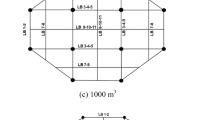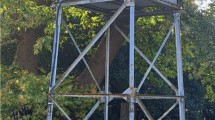Abstract
The behaviour coefficient is a parameter introduced in dimensioning codes in order to determine the internal forces and to estimate the inelastic deformations undergone by a structure. For each type of structure, a unique value is associated by various design codes. For the elevated water tank, considered as reverse pendulum structure, this coefficient assumes a constant value (R = 2) in the Algerian seismic code (RPA2003), while Eurocode 8 suggests to take as behaviour factor (q = 1). Recent researches have shown that this behaviour coefficient depends on several parameters. In this study, the effect of various parameters, such as the pedestal height, the ductility of the structure, the soil type and the seismic zone, on the behaviour of the elevated tanks is evaluated considering the current codes and standards. The energy method and the hydrodynamic model developed by Housner are, respectively, used to evaluate the elastic and the ultimate displacement at the top of the reservoir. As a main result of this research, a more realistic law is proposed to evaluate the behaviour coefficient of RC elevated tanks considering several influential parameters.












Similar content being viewed by others
References
DTU-1998, Règles de construction parasismiques PS 92. Applicables aux bâtiments. (Eyrolles, Paris, France, 1998).
CEN, EN 1998–4: Eurocode 8, Design of structures for earthquake resistance, part 4: silos, tanks and pipelines. (Brussels: European Committee for Standardization, Bruxelles, 2005).
ASCE 7–10, 2010, Minimum Design Loads for Buildings and Other Structures (American Society of Civil Engineers, Reston, Virginia, 2010).
DTR/B-C 2–48–2003, Algerian seismic code RPA2003 (National Center for Applied Research in Earthquake Engineering (CGS), Algiers, Algeria, 2003).
NZSEE-1998, Assessment and Improvement of the Structural Performance of Buildings in Earthquakes: Prioritisation, Initial Evaluation, Detailed Assessment, Improvement Measures: Recommendations of a NZSEE Study Group on Earthquake Risk Buildings (New Zealand Society for Earthquake Engineering, 2014).
T. Patel, J. Amin, B. Patel, Evaluation response reduction factor of RC framed staging elevated water tank using static pushover analysis. Int. J. Civ. Struct. Eng. 4(3), 215–226 (2014)
M.O. Mechiche, A. Bouheraoua, F. Chalah, O. Hellal, A. Bali, Global behaviour factor of frames with eccentric bracings and relationships with the ductility requirements. Appl. Mech. Mater. 330, 948–953 (2013). https://doi.org/10.4028/www.scientific.net/AMM.330.948
M. Mouzzoun, O. Moustachi, A. Taleb, Evaluation du facteur de comportement pour le calcul parasismique des bâtiments en béton armé. J. Mater. Environ. Sci. 4(1), 23–32 (2013)
R. Aghayari, S. Dardaei, Evaluating the effect of the thickness and yield point of steel on the response modification factor of RC frames braced with steel plate. KSCE J. Civ. Eng. 22(5), 1865–1871 (2018). https://doi.org/10.1007/s12205-017-1750-z
M. Masoudi, S. Eshghi, A.M. Ghafory, Evaluation of response modification factor (R) of elevated concrete tanks. Eng. Struct. 39, 199–209 (2012). https://doi.org/10.1016/j.engstruct.2012.02.015
R. Ghateh, M.R. Kianoush, W. Pogorzelski, Seismic response factors of reinforced concrete pedestal in elevated water tanks. Eng. Struct. 87, 32–46 (2015). https://doi.org/10.1016/j.engstruct.2015.01.017
AWWAD-110, Denver, CO, Wireand Strand-Wound Circular, Prestressed Concrete Water Tanks (American Water Works Association –AWWA, USA, 1995).
AWWAD-115, Denver, CO, Circular Prestressed Concrete Water Tanks with Circumferential Tendons (American Water Works Association –AWWA , USA, 1995).
NBCC-1970, National Building Code of Canada, Associate Committee on the National Building Code (National Research Council of Canada, Ottawa, ON, 1970).
NBCC-1975, National Building Code of Canada, Associate Committee on the National Building Code (National Research Council of Canada, Ottawa, ON, 1975).
NBCC-1990, National Building Code of Canada, Associate Committee on the National Building Code (National Research Council of Canada, Ottawa, ON, 1990).
NBCC-1995, National Building Code of Canada, Associate Committee on the National Building Code (National Research Council of Canada, Ottawa, ON, 1990).
NBCC-2005, National Building Code of Canada, Associate Committee on the National Building Code (National Research Council of Canada, Ottawa, ON, 2005).
NBCC-2010, National Building Code of Canada, Associate Committee on the National Building Code (National Research Council of Canada, Ottawa, ON, 2010).
D. Mitchell, P. Paultre, R. Tinawi, M. Saatcioglu, R. Tremblay, K. Elwood, J. Adams, R. Devall, Evolution of seismic design provisions in the national building code of Canada. Can. J. Civ. Eng. 37(9), 1157–1170 (2010). https://doi.org/10.1139/L10-054
G. Comeau, K. Velchev, C.A. Rogers, Development of seismic force modification factors for cold-formed steel strap braced walls. Can. J. Civ. Eng. 37(2), 236–249 (2010). https://doi.org/10.1139/L09-153
G.W. Housner, The dynamic behaviour of water tanks. Bull. Seismol. Soc. Am. 53(2), 381–387 (1963)
H. Hammoum, K. Bouzelha, D. Slimani, Seismic risk of RC water storage elevated tanks: Case study, in Handbook of materials failure analysis with case studies from the chemicals, concrete and power industries. (Butterworth-Heinemann, United Kingdom, 2016), pp. 187–216
V. Davidovici, A. Haddadi, Calcul pratique de réservoirs en zone sismique. Annales de l’ITBTP. 409 (1982).
J. Roux, Résistance des matériaux pratique Tome 2. (Eyrolles Ed. Paris- France, 1995).
AFNOR. DTU P18–702 BAEL 91 (révisés 99), Règles techniques de conception et de calcul des ouvrages et constructions en béton armé suivant la méthode des états limites. Fascicule 62, titre 1er du CCTG – Travaux section 1: béton armé. (February 2000).
E. Shdeed, A. Kassoul, Prise en compte de la ductilité dans les méthodes de renforcement des anciens bâtis. Damas. Univer. J. Eng. Sci. 18, 27–45 (2002)
S. Gieu, Ductilité des structures en béton armé. Mémoire d'ingénieur CNAM, Conservatoire national des arts et métiers de Paris, France. (2012).
Funding
The authors wish to thank the Algerian Ministry of higher education and scientific research for funding the University education research project (PRFU—N° A01L02UN150120180002) and Tassili Project (PHC—18MDU121).
Author information
Authors and Affiliations
Corresponding author
Ethics declarations
Conflict of interest
On behalf of all authors, the corresponding author states that there is no conflict of interest.
Additional information
Publisher's Note
Springer Nature remains neutral with regard to jurisdictional claims in published maps and institutional affiliations.
Rights and permissions
About this article
Cite this article
Ider, O., Hammoum, H., Bouzelha, K. et al. Evaluation of the Behaviour Coefficient of an Elevated RC Tank. J. Inst. Eng. India Ser. A 103, 1–15 (2022). https://doi.org/10.1007/s40030-021-00615-z
Received:
Accepted:
Published:
Issue Date:
DOI: https://doi.org/10.1007/s40030-021-00615-z




